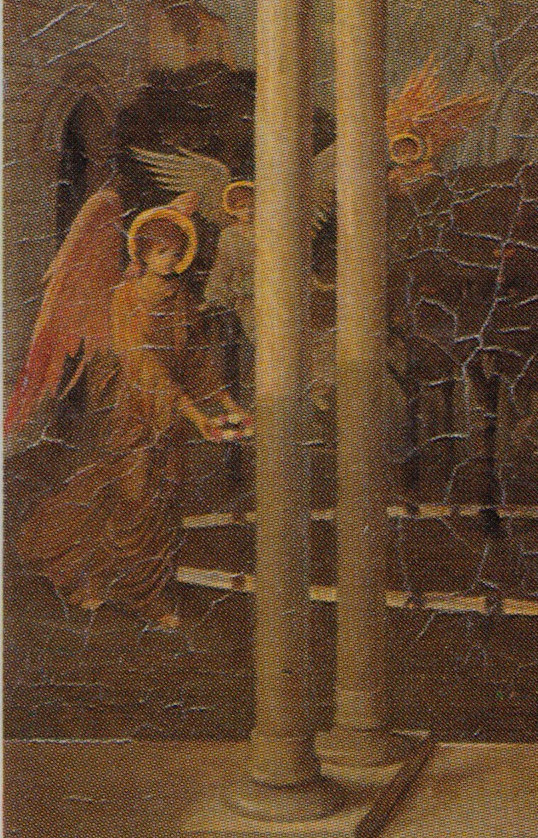
St. Cecilia by John Melhuish Strudwick (1849-1937). 1882. Oil on canvas. 37 ¾ x 25 inches (95.9 X 63.5 cm). Private collection. Provenance: W. Imrie of Liverpool, as of 1891 (featured in the Art-Journal that year). Image courtesy of Sotheby's, London.
This is Strudwick's earliest depiction of St. Cecilia, the patron saint of music. It originally belonged to his major patron George Holt. According to legend, which had recently been presented to the Victorians by Anna Jameson in her influential Sacred and Legendary Art, Cecilia was a Christian noble lady of Rome who, despite her vow of virginity, was forced by her parents to marry a pagan nobleman named Valerian. During the wedding, Cecilia sat apart singing to God in her heart. For that reason she was later declared the patron saint of musicians. When the time came for her marriage to be consummated, Cecilia told Valerian that watching over her was an angel of the Lord, who would punish him if he sexually violated her but would love him if he respected her virginity. When Valerian asked to see the angel, Cecilia replied that he could if he would go to the third milestone on the Via Appia and be baptized by Pope Urban I. After following Cecilia's advice, Valerian saw the angel standing beside her and crowning her with a chaplet of roses and lilies. Both Valerian and Cecilia were later martyred for their Christian beliefs (II: 202-5).

Closer view of the angels in Strudwick's painting.
In his earliest version of this subject Strudwick depicts the youthful saint standing upright and playing a portative organ. She is wearing a red robe which might symbolize either the blood of her martyrdom shed for her faith or divine love. She is standing in a cloister, like that found in a monastery or convent, with a garden in the background. Angels can be seen to the left, although St. Cecilia appears unaware of their presence. An apple tree stands to the right, perhaps included for the apple's symbolic reference to the Trinity: the apple's three parts, the skin, the flesh, and the core containing seeds, are said to represent respectively God the Father, who encompasses all, Jesus, who is the fruit that feeds us, and the seeds, which stand for the Holy Spirit that can bring new life.
Saint Cecilia is one of the great Pre-Raphaelite subjects. Her earliest depiction by members of the Brotherhood was by D.G. Rossetti, in his famous illustration for Tennyson's poem "The Palace of Art" for the Moxon Tennyson of 1857. St. Cecilia was drawn and/or painted by many of the Pre-Raphaelites and their associates in addition to Rossetti, including Elizabeth Siddal, Edward Burne-Jones, Simeon Solomon, Arthur Hughes, J. W. Waterhouse, Marie Spartali Stillman, Sidney Meteyard, Henry Ryland, and E.R. Frampton.
Bibliography
Fine Victorian Paintings, Drawings and Watercolours Sotheby's Belgravia (9 April 1974), lot 69, 64-65.
Jameson, Anna. Sacred and Legendary Art. Vol. II. London: Longman, 1848. Google Books Free ebook. Web. 30 September 2025.
Kolsteren, Steven. "The Pre-Raphaelite Art of John Melhuish Strudwick (1849-1937)." The Journal of Pre-Raphaelite and Aesthetic Studies I:2 (Fall 1988): 11, no. 9.
Shaw, George Bernard. "J.M. Strudwick." Art Journal (1891): 97-101 Hathi Trust Digital Library version of a copy in the University of Michigan Library. Web. 8 April 2014. [This was the original source for this web-page, as put online by George P. Landow; see the full text of Shaw's article which he provided.]
Created 9 April 2014
Last modified (commentary added) 30 September 2025